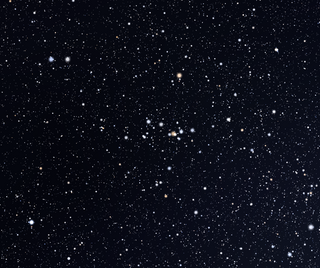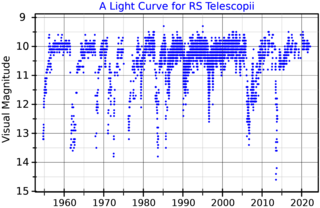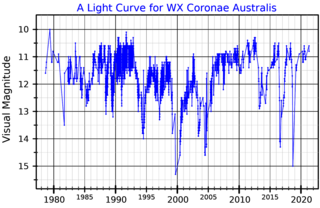Related Research Articles

Corona Borealis is a small constellation in the Northern Celestial Hemisphere. It is one of the 48 constellations listed by the 2nd-century astronomer Ptolemy, and remains one of the 88 modern constellations. Its brightest stars form a semicircular arc. Its Latin name, inspired by its shape, means "northern crown". In classical mythology Corona Borealis generally represented the crown given by the god Dionysus to the Cretan princess Ariadne and set by her in the heavens. Other cultures likened the pattern to a circle of elders, an eagle's nest, a bear's den, or even a smokehole. Ptolemy also listed a southern counterpart, Corona Australis, with a similar pattern.

Perseus is a constellation in the northern sky, being named after the Greek mythological hero Perseus. It is one of the 48 ancient constellations listed by the 2nd-century astronomer Ptolemy, and among the 88 modern constellations defined by the International Astronomical Union (IAU). It is located near several other constellations named after ancient Greek legends surrounding Perseus, including Andromeda to the west and Cassiopeia to the north. Perseus is also bordered by Aries and Taurus to the south, Auriga to the east, Camelopardalis to the north, and Triangulum to the west. Some star atlases during the early 19th century also depicted Perseus holding the disembodied head of Medusa, whose asterism was named together as Perseus et Caput Medusae; however, this never came into popular usage.

R Coronae Borealis is a low-mass yellow supergiant star in the constellation of Corona Borealis. It is the prototype of the R Cor Bor class of variable stars, which fade by several magnitudes at irregular intervals. R Coronae Borealis itself normally shines at approximately magnitude 6, just about visible to the naked eye, but at intervals of several months to many years fades to as faint as 15th magnitude. Over successive months it then gradually returns to its normal brightness, giving it the nickname "reverse nova", after the more common type of star which rapidly increases in brightness before fading.

W Mensae is an unusual yellow supergiant star in the Large Magellanic Cloud in the southern constellation Mensa. It is an R Coronae Borealis variable and periodically decreases in brightness by several magnitudes.

An R Coronae Borealis variable is an eruptive variable star that varies in luminosity in two modes, one low amplitude pulsation, and one irregular, unpredictably-sudden fading by 1 to 9 magnitudes. The prototype star R Coronae Borealis was discovered by the English amateur astronomer Edward Pigott in 1795, who first observed the enigmatic fadings of the star. Only about 150 RCB stars are currently known in our Galaxy while up to 1000 were expected, making this class a very rare kind of star.

DY Persei is a variable star and carbon star in the Perseus constellation. At maximum it is 11th magnitude and at its faintest it drops to 16th magnitude. DY Persei is the prototype of the very rare DY Persei class of variables that pulsate like red variables but also fade from sight like R Coronae Borealis variables.
Gamma Coronae Borealis, Latinized from γ Coronae Borealis, is a binary star system in the northern constellation of Corona Borealis. It is visible to the naked eye with an apparent visual magnitude of 3.83. Based upon an annual parallax shift of 22.33 mas as seen from Earth, it is located about 146 light years from the Sun. The system is moving closer to the Sun with a radial velocity of about −15 km/s.
Theta Coronae Borealis, Latinized from θ Coronae Borealis, is a binary star system in the constellation Corona Borealis. It shines with a combined apparent visual magnitude of 4.13. There are two components: Theta Coronae Borealis A is of apparent magnitude 4.16, while Theta Coronae Borealis B lies around 1 arcsecond distant and has an apparent magnitude of 6.29. The system is located around 375 light-years from Earth, as estimated from its parallax of 8.69 milliarcseconds. It is estimated to be 85 million years old, with the primary star expected to remain on the main sequence burning its core hydrogen for another 75 million years and the secondary around 500 million years. Both stars will cool and expand once their core hydrogen is exhausted, becoming red giants.

Epsilon Coronae Borealis, Latinized from ε Coronae Borealis, is a multiple star system in the constellation Corona Borealis located around 230 light-years from the Solar System. It shines with a combined apparent magnitude of 4.13, meaning it is visible to the unaided eye in all night skies except those brightly lit in inner city locations. It is an orange giant around 1.7 times as massive as the Sun of spectral type K2III, which has exhausted its core fuel supply of hydrogen and swollen to 21 times the Sun's diameter and 151 times its luminosity. That is, Epsilon Coronae Borealis's diameter is about one-quarter of Mercury's orbit. Its surface temperature has been calculated to be 4365 ± 9 K, or 4406 ± 15 K. It is thought to be around 1.74 billion years old.
Delta Coronae Borealis, Latinized from δ Coronae Borealis, is a variable star in the constellation Corona Borealis. Its apparent magnitude varies regularly between apparent magnitude 4.57 and 4.69, and it is around 170 light-years distant.

RY Sagittarii is a yellow supergiant and an R Coronae Borealis type variable star in the constellation Sagittarius. Although it ostensibly has the spectrum of a G-type star, it differs markedly from most in that it has almost no hydrogen and much carbon.

Z Ursae Minoris is a carbon star and R Coronae Borealis variable in the constellation Ursa Minor.

RS Telescopii, abbreviated RS Tel, is a variable star in the southern constellation of Telescopium. It is a dim star with an apparent visual magnitude of 10.67, which is much too faint to be visible without a telescope. The variability of this star was discovered by Evelyn F. Leland and announced by Edward C. Pickering in 1910. It was first studied by Cecilia H. Payne in 1928 at the Harvard College Observatory.

V Coronae Australis is a R Coronae Borealis variable star in the constellation Corona Australis. These are extremely hydrogen-deficient supergiants thought to have arisen as the result of the merger of two white dwarfs; fewer than 100 have been discovered as of 2012. V Coronae Australis dimmed in brightness from 1994 to 1998.

WX Coronae Australis is an R Coronae Borealis star in the constellation Corona Australis, one of the brightest examples of this extremely rare class of variable star. Despite the rarity, Corona Australis hosts another R CrB star, V Coronae Australis.

V Coronae Borealis is a Mira-type long period variable star and carbon star in the constellation Corona Borealis. Its apparent magnitude varies between 6.9 and 12.6 over a period of 357 days

Sigma Coronae Borealis is a star system in the constellation of Corona Borealis. It is a quintuple star system containing three sunlike main-sequence stars and two other low-mass stars. The combined visual magnitude is 5.3 and the system lies 74 light years from Earth. σ CrB A is the variable star TZ Coronae Borealis.

S Apodis is an R Coronae Borealis variable star located in the far southern constellation Apus. These are extremely hydrogen-deficient supergiants thought to have arisen as the result of the merger of two white dwarfs; fewer than 100 have been discovered as of 2012. Located around 13,000 light-years distant, it shines with a luminosity approximately 960 times that of the Sun and has a surface temperature of 3916 K.

DY Centauri is a variable star in the constellation Centaurus. From its brightness, it is estimated to be 7000 parsecs (23000 light-years) away from Earth.

Michel Spiro is a French physicist.
References
- ↑ Tisserand, P.; Marquette, J. B.; Wood, P. R.; Lesquoy, É.; Beaulieu, J. P.; Milsztajn, A.; Hamadache, C.; Afonso, C.; Albert, J. N.; Andersen, J.; Ansari, R.; Aubourg, É.; Bareyre, P.; Charlot, X.; Coutures, C.; Ferlet, R.; Fouqué, P.; Glicenstein, J. F.; Goldman, B.; Gould, A.; Gros, M.; Haissinski, J.; De Kat, J.; Le Guillou, L.; Loup, C.; Magneville, C.; Maurice, É.; Maury, A.; Moniez, M.; et al. (2008). "R Coronae Borealis stars in the Galactic bulge discovered by EROS-2". Astronomy and Astrophysics. 481 (3): 673. arXiv: 0801.1680 . Bibcode:2008A&A...481..673T. doi:10.1051/0004-6361:20078814.
- 1 2 Miller, A. A.; Richards, J. W.; Bloom, J. S.; Cenko, S. B.; Silverman, J. M.; Starr, D. L.; Stassun, K. G. (2012). "Discovery of Bright Galactic R Coronae Borealis and Dy Persei Variables: Rare Gems Mined from Acvs". The Astrophysical Journal. 755 (2): 98. arXiv: 1204.4181 . Bibcode:2012ApJ...755...98M. doi:10.1088/0004-637X/755/2/98.
- ↑ Tisserand, P.; Wood, P. R.; Marquette, J. B.; Afonso, C.; Albert, J. N.; Andersen, J.; Ansari, R.; Aubourg, É.; Bareyre, P.; Beaulieu, J. P.; Charlot, X.; Coutures, C.; Ferlet, R.; Fouqué, P.; Glicenstein, J. F.; Goldman, B.; Gould, A.; Gros, M.; De Kat, J.; Lesquoy, É.; Loup, C.; Magneville, C.; Maurice, É.; Maury, A.; Milsztajn, A.; Moniez, M.; Palanque-Delabrouille, N.; Perdereau, O.; Rich, J.; et al. (2009). "New Magellanic Cloud R Coronae Borealis and DY Persei type stars from the EROS-2 database: The connection between RCBs, DYPers, and ordinary carbon stars". Astronomy and Astrophysics. 501 (3): 985. arXiv: 0905.3224 . Bibcode:2009A&A...501..985T. doi:10.1051/0004-6361/200911808.